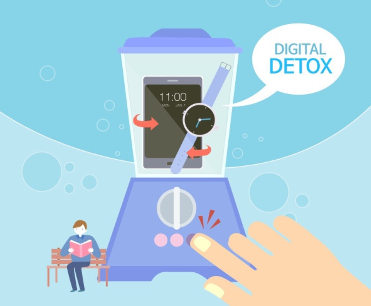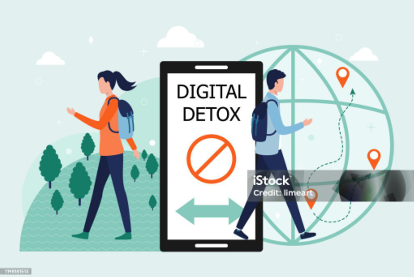How deeply are digital devices rooted in your life? Perhaps, for most modern people, digital devices occupy a certain part of each person’s life. Digital devices are deeply ingrained in our society beyond just each person’s individual live. When we order hamburgers, we don’t stand in front of employees, but instead stand in front of kiosks and order our meals. In the field of education, discussions on the introduction of digital devices such as digital textbooks and AI technology are also actively underway. In this way, we take a step forward in the digital age by using digital devices throughout our society. Because of their convenience and excellent accessibility, we also tend to think that the digital age has more advantages than disadvantages. But does the digital age really have only advantages?
As digital devices penetrate deeply into our society, the dependence on digital devices has increased considerably, According to a survey of 1,200 men and women aged 13 to 69, (Embrain, a Korean market research company, 2024) 85.3% of respondents said they would be inconvenienced if digital devices disappeared, and 71.9% said they habitually use smartphones without specific purpose. This obsession with digital devices among modern individuals is called “digital overdependence.” Digital overdependence is a problem for all generations, but especially in the younger generation. In the above survey, 52% of teenagers and 63% of twenties answered that it would be difficult for them to live their daily life properly without a smartphone. In addition, when asked if having a smartphone nearby makes it difficult to concentrate on other tasks, only 17.5% of fifties agreed, compared to a striking 50% of teenagers. Thus, young people in our society are already exposed to digital overdependence. Because of this reality, education workers are concerned about students’ excessive immersion in digital devices and overdependence on the introduction of digital education. Then why is digital overdependence so problematic?
That’s because digital overdependence has a big impact on our lives. First, it can lead to dopamine addiction. Dopamine is a type of neurotransmitter present in the central nervous system and is secreted when experiencing emotions such as joy, pleasure, or excitement. Dopamine can be secreted through regular and stable exercise or sufficient sleep, but it can be easily triggered by repeatedly watching stimulating and short videos, which can result in excessive dopamine levels. If dopamine is obtained appropriately, it is beneficial in many ways, including motivation, happiness, memory, cognitive ability, and exercise regulation, but if it is excessive, it can cause anxiety, insomnia and impair thinking and judgment, which can lead to unrealistic thoughts and delusions. In severe cases, the brain’s reward system can be overstimulated and interfere with normal daily life.
Moreover, there is a possibility of harming your health. A typical physical problem caused by excessive digital use is forward head posture. To put it simply, forward head posture occurs when the cervical spine is excessively bent forward, resulting in a protruding head position. This can cause problems such as a slipped disc in the back as well as neck and shoulder muscle pain. Also, looking at the screen for the Internet for a long time can cause problems such as eye fatigue, dryness, and decreased vision. In fact, increase in internet use due to online classes has led to a rise in vision problems among students. According to a survey of 7,003 elementary school students in 25 schools in Seoul (Our Children's hospital, 2021) the prevalence rate of myopia(short-sightedness) in the lower and upper grades before COVID-19 was 27% and 47%, but rose to 38% and 63%, highlighting the concerning impact of increased screen time on children’s eyesight.
Digital addiction can degrade the quality of life. Have you ever forgotten what you’re trying to search for by turning on the search engine? Or have you ever called a friend, but you couldn’t remember what to say? We’ve all had this kind of experience at least once. If these experiences are repeated several times, we should suspect digital dementia. It refers to a symptom that relies too much on digital devices, the result of developed technologies, and results in a loss of recognition, calculation, and memorization. Dementia is likely to occur a lot in the elderly, but in the digital age, digital dementia occurs frequently in the younger generation regardless of age.
The average daily mobile usage time per Korean as of 2021(data.ai, a global mobile market data analysis company, 2021) exceeded 5 hours, ranking third in the world. Mobile usage time is increasing compared to last year. This has caused people to experience visual fatigue, sleep disorders, and social isolation. Many people voluntarily try a digital detox with the motivation to reduce stress and anxiety caused by excessive technology use or to refocus on social interactions and activities offline. Digital detox is a compound word of digital and detox, and refers to the behavior of individuals spontaneously refraining from using digital devices such as smartphones, computers, and social media platforms. This form of detox is gaining popularity as people spend more time on digital devices and the Internet.

This digital detox can restore the vitality of our lives, which are tired from the digital overdependence mentioned earlier. Don’t you lie down on the bed and sleep with your smartphone after finishing your day’s work? Most people lie in bed after a day’s work using their smartphones until they go to bed. Like this, using your smartphone until just before going to bed will destroy the quality and pattern of your sleep. If you keep your smartphone away through digital detox, you can get a higher quality of sleep. It can also improve concentration and relieve stress by blocking constant information and notifications from digital devices. Along with digital overdependence, the problem of dopamine addiction can be solved with digital detox. Dopamine is excessively obtained from easily accessible short from videos. If you practice digital detox, you will have the opportunity to stay away from excessive dopamine and get the right amount of dopamine you need.
How can this kind of digital detox be practiced? Digital detox does not follow a fixed format, there are many ways to practice it. Here are several ways to practice digital detox.
First, create a “digital free zone.” Essentially, this involves designating spaces where digital devices are prohibited. If you use digital devices late before going to bed, set the bed to a digital free zone. If you can’t concentrate on learning with digital devices, set the learning spaces a digital free zone and forbid the use of digital devices there. In order to use digital devices, it creates the inconvenience of moving to other spaces and moves away from digital devices. In my case, I designated my bed in a digital free zone for two days and didn’t use digital devices while in bed. The biggest advantage was that I couldn’t use digital devices in bed, so I didn’t lie down for a long time and my back didn’t hurt. Also, I didn’t use my cell phone just before I went to bed, so I fell asleep right away, and I didn’t get tired when I woke up early as usual. You can also utilize screen time tracking. Screen time is a function that records and analyzes how users use their smartphones. In the case of apps that are habitually used without specific purpose such as social media, monitoring and limiting your usage through screen time can aid in your digital detox.
Also, as digital detox is popular these days, many stores are adopting digital detox. There are pop-up stores where you can hand in your smartphone and experience it, and restaurants that give discounts on food and drink after leaving your cell phone to focus on conversation. Additionally, some people enjoy digital detox camps in areas with poor phone reception, allowing them to connect with nature while disconnecting from devices.

If I give you a week of digital detox that you can practice in a simple way, would you like to try it? Many might hesitate to commit. According to Digital Dementia and Digital Detox-related Awareness Survey, (Embrain,2024) 80.2% of respondents recognize the need for a digital detox, while 79.5% express an intention to practice it. This indicates a high awareness of the necessity for digital detox. However, 76.5% of respondents said it would be difficult to actually implement a digital detox, highlighting the challenges of relinquishing familiarity with digital devices in real life. In fact, VMware Korea, a cloud infrastructure and business mobility solutions company, has published a study examining the current state of digital workspaces for office workers across various industries. According to it, office workers are using one or more devices and applications for their work, given that a variety of work has recently been based on digital. Respondents are using an average of 2.4 devices and 5.4 applications for their work, and that they check emails and messages, respond to inquiries, conduct financial transactions, and manage business files through digital devices. Students are also using many devices for learning, and the education circle is also considering the introduction of digital textbooks, and this trend is expected to increase in the future as digital devices become more integrated into society. Given this context, keeping digital away can interfere with everyday life.
Ultimately, completely blocking digital use is difficult due to the personal and social factors mentioned above. Digital overdependence can be viewed as a byproduct of a social atmosphere that seeks to chase a high of dopamine in a hyper-stimulating environment. Therefore, we should strive to become healthier both physically and mentally by acquiring dopamine through valuable activities, not through digital dopamine. However, since we cannot completely block the digital in our lives, an excessive digital detox can lead to greater stress and anxiety. Therefore, it is crucial to understand our own conditions clearly and address them appropriately. In other words, digital detox should be gradually increased and strengthened just like exercise. Recent issues such as sleep deprivation and stress may stem from our close relationship with digital devices. Why not join us in becoming healthier individuals, both mentally and physically, through a balanced approach to digital detox?

